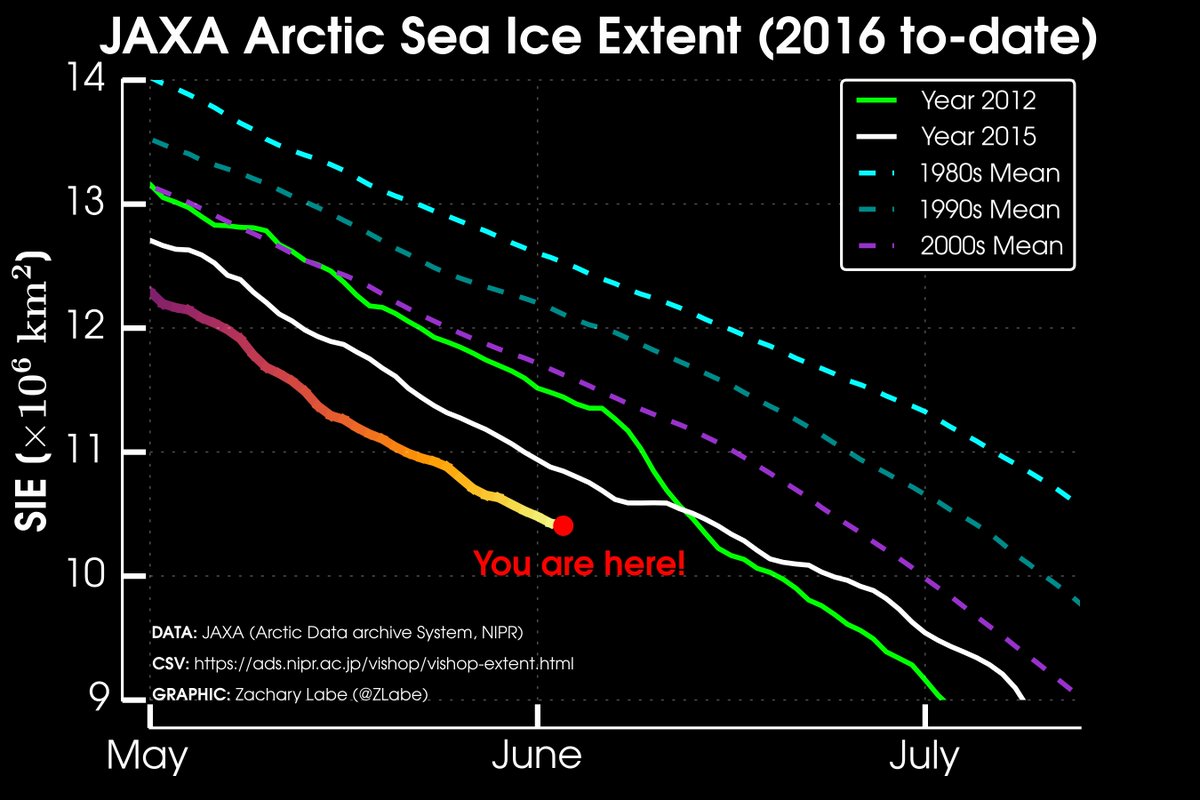“Even
the most pessimistic projections have turned out to be too
conservative so far, as pulses of unusually mild air and
milder-than-average ocean temperatures have eroded the unusually thin
sea ice cover from above and below.”
Arctic
sea ice set a record low every single day in May
2
May, 2016
After
Arctic sea ice set a record
low annual maximum in
March, it was widely expected that this summer melt season would rank
among the top 5 or 10 lowest melt seasons on record since the dawn of
satellite observations there in 1979.
However,
even the most pessimistic projections have turned out to be too
conservative so far, as pulses of unusually mild air and
milder-than-average ocean temperatures have eroded the unusually thin
sea ice cover from above and below.
Unusually
thin and even totally absent sea ice cover is emerging on both the
Atlantic and Pacific sides of the Arctic, raising the possibility of
a new sea ice record low and possibly a hastening of when the first
ice-free Arctic summer takes place.
During
every day in May, for example, sea ice extent — which measures how
much ocean is at least 15% ice-covered — was lower than ever
observed since 1979. This means the 2016 sea ice extent is melting
faster than at the same time of the year in 2012, when sea ice set a
record low. And unless a major weather pattern change happens soon,
it is becoming more likely that a new record low could be set this
year.
Near-surface
temperature departures from the median in terms of degree days
above/below freezing. The red line shows that the period from
February onward has been off the charts warm.
IMAGE:
NSIDC
"Yes,
from what I can see, since early May we have been at record daily
lows as assessed over the period of satellite observations,"
said Mark Serreze, the director of the National Snow and Ice Data
Center (NSIDC) in Boulder, Colorado.
A
satellite sensor used for measuring sea ice extent failed in April,
adding some uncertainty to the data, but that has been resolved,
Serreze told Mashable in an email. "This is not
a calibration issue," he said.
"
Sea
ice extent through the end of May, with the blue line showing 2016.
IMAGE:
NSIDC
"As
has been the case for awhile, extent is quite low in the Atlantic
side of the Arctic, but big open water areas have opened up in the
Beaufort Sea" as well, Serreze said. The Beaufort Sea is
situated north of Alaska, on the Pacific side of the Arctic.
Satellite
images show that sea ice is poised to break up between the Beaufort
and Chukchi Seas, about two months ahead of schedule.
Zack
Labe, a PhD student at the University of California at Irvine who is
conducting sea ice research, told Mashable via
Twitter that record warmth in the Arctic this winter "has really
preconditioned the ice for the peak summer melt season."
"We
are entering the melt season with the worst sea ice conditions in our
satellite era during the residuals of the likely warmest year on
record. It just can't mean good things are to come unfortunately for
the sea ice."
What
happens with the sea ice cover will have widespread ramifications for
the approximately 400,000 residents of the Arctic region, as well as
the iconic plants and animals that inhabit this region. Species such
as seals, walruses and polar bears depend on sea ice cover for
breeding, hunting and rest, and without it they can suffer from
malnutrition and experience population declines.
Due
to the dwindling sea ice cover, walruses have been showing up by
the tens
of thousandson
beaches in Alaska and Russia, seeking rest in between arduous treks
of hundreds of miles for food.
Sea
ice melt is also making the region more accessible for cargo ships,
military vessels and oil and gas drilling. This summer,
the 1,725-person vessel Crystal Cruises' Serenity,
plans to make the first
transit of the Northwest Passage by
such a large passenger hip.
Up
until a decade ago, the Northwest Passage was still inaccessible, as
it had been throughout all of human history.
In
addition, sea ice loss can alter weather patterns in the Arctic, with
some scientists proposing connections to storms affecting far broader
regions, such as the U.S. and Europe.
Sea
ice melt does not directly raise sea levels, however, since the ice
is already floating in the water.
Beautiful view tonight from Hotel Arctic near the Ilulissat Icefjord, #Greenland
http://hotelarctic.com/om_hotel_arctic/webcam/ …




 Zack Labe
Zack Labe 

No comments:
Post a Comment
Note: only a member of this blog may post a comment.